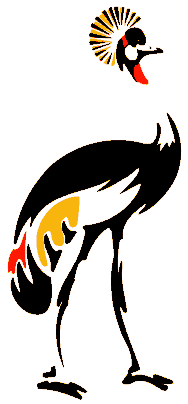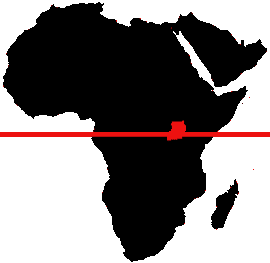
Independent since 1962, the country has been through tough political situations, including dictatorship of Idi Amin Dada and civil wars. Political stability came back in the late eighties, as President Yoweri Museveni took over, in 1986.

Uganda is bordered by Sudan to the north, Zaire to the west, Rwanda and Tanzania to the south, and Kenya to the east. The country is rather high, occupying a plateau that averages 915m in the north, and rises to 1,340m near Kampala. The East Rift System occupies the southwestern border near equator, and includes Uganda's highest point, Mount Stanley (5,110m). Almost one one-fifth of Uganda is covered by lakes. The country has a complex system of rivers, many of which (in the south of the country) drain into world's third largest lake, Lake Victoria.
There ara two distinct wet seasons (March-May and October-November). The northeast of the country, its driest area, receives about 812 mm of rainfall between April and August, while annual rainfall near Lake Victoria averages 1,500 mm. Temperatures are moderated by altitude, and range from 35°C (on the Rift floor near the sudanese border) to 5°C in the southwestern highlands.
The most valuable Ugandan mineral is copper. Smaller amounts of gold, tungsten, tin, lead, and wolfram have been extracted, primarily in the southwest.
Uganda has many national parks and is renowned for its wildlife. Tourism, once a leading sector in the country's economy, almost disapeared between 1972 and the nineties, due to political instabillity, and never regained its position.
In 1995, Ugandan population was estimated to 21.3 millions. Healthcare severly decreased since independance; infant mortality reaching 115 p 1,000 , an alarming impact of AIDS (about 1,5 millions of Ugandan would be HIV-positive) lead to an average life span as low as 45 years.

Two major ethnies share Uganda: the Bantus (about three fourth of the population) live in the south, whereas Nilotic populations live in the north of the country. Uganda counts many refugees from other african countries (Rwanda, Sudan, Zaire). Almost all the 74,308 Indians and 9,533 Europeans listed in the 1969 census have since left, but the Indian community tends to be beack in the country since the last three-five years, massively investing in the ugandan economy.
KAMPALA, the capital and only large urban center, contains nearly ten times as many people as Jinja, the second-largest city. Education is not the main strength of Uganda, with an illetaracy rate of nearly 43% of the population.
LANGUAGE
Alhtough English is the official language, SWAHILI is widely spoken, and Luganda is common in the south.
|

The colonial period was the reign of an economy based on raw materials exportation for the european markets. the Indian community controled most of Uganda's credit and trade activities untill 1972, as Amin expelled them. With civil wars and riots of the seventies and early eighties, corruption, black market and banditry flourished, untill 1986. Since 1986, the government has actively fought corruption, and the foreign aid, along with foreign investment, has increased.
Uganda received formal independance on October 9,1962. Mr Milton Obote then became prime minister, in an uneasy coalition. As the coalition broke down, the regime became more of a dictatorship, leading to the exile of some ethnies, while federalism was left appart and the army took a promenient role in politics. On january 25,1971, Mr Obote has been overthrown in a military coup led by Idi Amin Dada, formerly Obote's Chief of the army.
Idi Amin Dada imposed his dictatorship over the country until 1978, as he was disloged by the Tanzanian military response to an invasion.
After an unstable 18-month period, Obote came back to power in December, 1980, after elections widely considered fraudulent.
Yoweri Musevini then rose a guerilla movement (later called the NRM) to oppose Obote.
On July 27, 1985, Obote was again overthrown in a military coup led by the army. After six months of tension and fighting, the NRM marched on Kampala, and, in march,1986, took full control over the country.
The NRM has ever since concentrated on restoring order, fighting corruption, developping the economy and seting up a new social order.
Uganda has gained international recognition thanks to the historical visit of President William J. Clintonin may, 1998.
| OFFICIAL NAME. |
Republic of Uganda |
| LAND |
Area: 236,036 sq km (91,134 sq mi).
Capital and largest city: Kampala (1980 pop., 458,503).
Co-capital: Entebbe (1980 pop., 21, 289).
Elevations: highest--Margherita Peak, 5,109 m (16,762 ft);
lowest--914 m (3,000 ft), along Albert Nile. |
| PEOPLE |
Population (1995 est.): 21,300,000;
Official language: English.
Major religions: Roman Catholicism, Protestantism, Islam. |
| EDUCATION AND HEALTH. |
Literacy (1985): 57% of adult population.
Universities (1988): 2.
Hospital beds (1983): 20,343. |
| ECONOMY. |
GNP: $3.7 billion;
Foreign trade:
imports: $1.17 billion
exports: $555.3 million;
Currency: Uganda shilling.
Current account balance: $-114 million
Debt service: 24.1% of exports
Total debt stock: $3.2 billion
Budget deficit: 1.8% of GDP |
|

